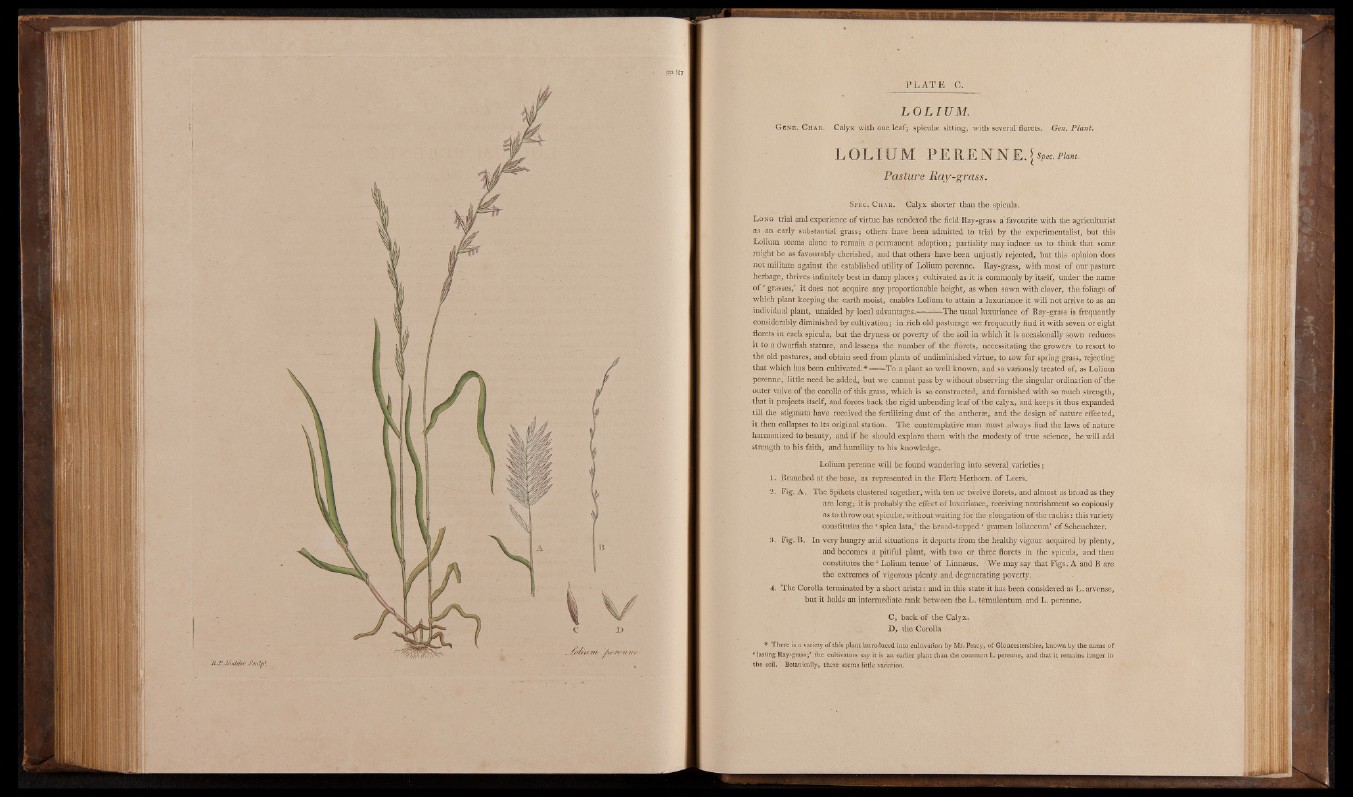
LOLIUM.
Gene. Char. Calyx with one leaf; spiculae sitting, with several’florets. Gen. Plant.
LOLIUM P E R E N N E .{^ .« -
Pasture Ray-grass.
Spec. Char. Calyx shorter than the spicula.
Long trial and experience o f virtue has rendered the field Ray-grass a favourite with the agriculturist
as an early substantial grassj others have been admitted to trial by the experimentalist, but this
Lolium seems alone to remain a permanent adoption; partiality may induce us to think that some
might be as favourably cherished, and that others have been unjustly rejected, but this opinion does
not militate against the established utility o f Lolium perenne. Ray-grass, with most of our pasture
herbage, thrives infinitely best in damp places j cultivated as it is commonly by itself, under the name
of ‘ grasses,’ it does not acquire any proportionable height, as when sown with clover, the foliage of
which plant keeping the earth moist, enables Lolium to attain a luxuriance it will not arrive to as an
individual plant, unaided by local advantages.----- -—The usual luxuriance of Ray-grass is frequently
considerably diminished by cultivation; in rich old pasturage we frequently find it with seven or eight
florets in each spicula, but the dryness or poverty of the soil in which it is occasionally sown reduces
it to a dwarfish stature, and lessens the number of the florets, necessitating the growers to resort to
the old pastures, and obtain seed from plants of undiminished virtue, to sow for spring grass, rejecting
that which has been cultivated.*— —To a plant so well known, and so variously treated of, as Lolium
perenne, little need be added, but w e cannot pass by without observing the singular ordination of the
outer valve o f the corolla of this grass, which is so constructed, and furnished with so much strength,
that it projects itself, and forces back the rigid unbending leaf of the calyx, and keeps it thus expanded
till the stigmata have received the fertilizing dust of the antherae, and the design of nature effected,
it then collapses to its original station. The contemplative man must always find the laws of nature
harmonized to beauty, and if he should explore them with the modesty o f true science, he will add
strength to his faith, and humility to his knowledge.
Lolium perenne will be found wandering into several varieties;
1. Branched at the base, as represented in the Flora Herborn. of Leers.
2. Fig. A. The Spikets clustered together, with ten or twelve florets,-and almost as broad as they
are long} it is probably the effect of luxuriance, receiving nourishment so copiously
as to throw out spiculae, without waiting for the elopgation of the rachis: this variety
constitutes the ‘ spica lata,’ the broad-topped * gramen loliacenm’ of Scheuchzer.
3. Fig. B. In very hungry arid situations it departs from the healthy vigour acquired by plenty,
and becomes a pitiful plant, with two or three florets in the spicula, and then
constitutes the | Lolium tenue’ o f Linnaeus. We may say that Figs. A and B are
the extremes of vigorous plenty and degenerating poverty.
4. The Corolla terminated by a short arista: and in this state it has been considered as L. arvense,
but it holds an intermediate rank between the L. temulentum and L. perenne.
C, back o f the Calyx.
D, the Corolla
* There is a variety of this plant introduced into cultivation by Mr. Peacy, of Gloucestershire, known by the name o f
‘ lasting Ray-grass;’ the cultivators say it is an earlier plant than the common L. perenne, and that it remains longer in
the soil. Botanically, there seems little variation.